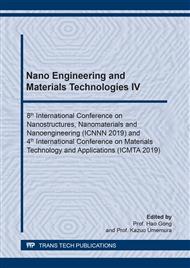p.29
p.36
p.44
p.50
p.55
p.61
p.67
p.73
p.81
Modification and Scale-Up Process of Citrogypsum to α-Calcium Sulfate Hemihydrate over Sodium Chloride Solution
Abstract:
It describes the development of a marketable citrogypsum which is also a by-product of citric acid production from laboratory scale to pilot scale. The modification of b-phase citrogypsum was carried out in different sodium chloride solution at 95oC for 7 hours under atmospheric pressure to α-calcium sulfate hemihydrate (α-CaSO4∙0.5H2O, α-HH). This can be achieved in the laboratory scale experiment. The phase analysis of a citrogypsum was confirmed by XRD technique demonstrated that mostly made up of calcium sulfate dihydrate (CaSO4∙2H2O, DH). The dehydration and phase transformation of citrogypsum to α-HH were conducted by DSC thermograms which were presented two endothermic peaks in the range 150-180oC of citrogypsum and an exothermic peak at 290 to 300oC, resulting that the product being α-HH when the 4M and 5M sodium chloride solutions were used. The outcome products were presented in a plate-like shape of citrogypsum but a hexagonal shape of α-HH. The experiment scaled up for modification of DH up to 100% in a batch reactor at the same condition with the 4M sodium chloride solution. The results showed that α-HH was obtained within 15 to 60 min after that calcium sulfate anhydrous (CaSO4, AH) had been formed. The non-isothermal of DSC was an adapted method to investigate kinetics study of DH to α-HH transformation under the optimum condition with a model fitting dα/dt = -3k (α2) for predicting the process compared to the experiment values. In addition, the coefficient of determination (R2) from estimation and experiment value was 0.9940. Hence, the model equation was completely represent data.
Info:
Periodical:
Pages:
55-60
Citation:
Online since:
May 2020
Keywords:
Price:
Сopyright:
© 2020 Trans Tech Publications Ltd. All Rights Reserved
Share:
Citation:


